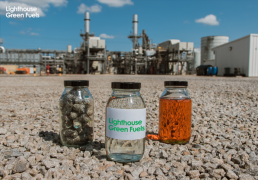Aviation Decarbonisation: Navigating the Shift from Fossil to Sustainable Aviation Fuel
In the ever-evolving realm of aviation, sustainability has taken centre stage, prompting a revolutionary shift in the way we approach fuel. At Alfanar Projects we proudly champion this movement towards a greener future, leading the way through transparency and innovative solutions. Let's dive into the pivotal differences between Sustainable Aviation Fuel (SAF) and traditional fossil fuels, exploring their production, composition, and environmental impact.
As aviation fuel undergoes a paradigm shift, understanding the essence of this change begins with production processes. Conventional jet fuels have long been the backbone of the industry, derived from finite fossil resources. However, #SAF offers a departure from this reliance, embracing abundant renewable feedstocks like municipal solid waste, waste oils or forestry residues. This shift not only diversifies our fuel sources but also aligns with the aviation sector's commitment to reducing its environmental footprint.
The composition of aviation fuel plays a crucial role in shaping its impact on the environment. By prioritising sustainable feedstocks and leveraging advanced refining processes, SAF stands out with a cleaner composition and delivers a greener alternative without compromising performance. This nuanced understanding of composition is key for businesses seeking to make sustainable choices in their fuel procurement.
Moving beyond composition, the environmental impact of aviation fuels extends to factors such as particulate matter emissions and overall air quality. SAF excels in this arena, significantly lowering greenhouse gas emissions throughout its lifecycle. The production and use of SAF not only contribute to reduced carbon footprints but also enhance overall air quality, making it a responsible choice for businesses committed to minimising their environmental impact. Replacing fossil fuels with SAF (without the use of carbon capture technologies enhancing this figure even further) offers up to 80% emissions savings compared to the use of conventional jet fuel. This is achieved by reusing carbon that has already been present in the feedstock's lifecycle, instead of generating additional CO2 into the atmosphere.
We stand as pioneers in the production of advanced sustainable fuel at commercial scale, contributing 10% to the UK’s overall Jet Zero strategy 2030 target. Lighthouse Green Fuels is set to become Europe’s largest advanced #waste-to-SAF facility, saving over 750,000 tonnes of #CO2 emissions annually once commercial operation starts. Our commitment to transparency ensures that our clients have access to comprehensive information about the origin, composition, and environmental performance of the aviation fuels we provide. By embracing innovative solutions, we empower businesses to make informed decisions that align with their sustainability goals.
In conclusion, the aviation industry is at a crossroads, and the choice between traditional fossil fuels and SAF is pivotal. With a deep understanding of the nuanced differences in production processes, composition, and environmental impact, businesses can confidently navigate this transition. Join us in charting the course towards an aviation industry that embraces the principles of environmental responsibility and technology innovation – and, as a result, creates a sky that is undeniably greener and more sustainable.
Advancing Sustainable Aviation: Challenges and Opportunities in the Mission for Net Zero
11.01.2024 In a recent update on Sustainable Aviation Fuel (SAF), the International Air Transport Association (IATA) shared encouraging data, revealing that SAF production volumes soared to over 600 million litres in the past year, a remarkable doubling from the figures of 2022. Despite this significant progress, SAF still accounted for merely 3% of all renewable fuels produced in 2023, with a staggering 97% directed to other transport sectors.
Lighthouse Green Fuels will play a pivotal role in the ongoing decarbonisation efforts within the aviation sector, producing 165 million litres of SAF annually once the commercial operation commences in 2028, Additionally, Alfanar aims to develop two more SAF plants within the next 5 years, further contributing to the industry's sustainability goals.
However, the aviation industry faces a critical juncture in its mission to achieve net-zero carbon emissions by 2050. To be on the trajectory for success, renewable fuel production needs to surge to 25% to 30% by 2030, a substantial leap from the current 3%. By the end of this year, the target is to reach 6%, tripling the production figures from 2022. While this is a commendable advancement, it still only addresses a mere 0.53% of the global aviation demand.
One of the key hurdles in the widespread adoption of SAF is the persistent challenge of cost and the lack of policy and price support for SAF producers and airlines. Despite the rapid growth in aviation emissions, surpassing those of rail, road, or shipping on a year-on-year basis, the sector remains in need of substantial backing to make sustainable practices economically viable.
Interestingly, it has been estimated that a significant 85% of SAF facilities planned for construction over the next five years will rely on Hydroprocessed Esters and Fatty Acids (HEFA) production technology. HEFA predominantly utilises inedible animal fats (tallow), used cooking oil, and industrial grease as feedstock. While HEFA is a valuable contributor, there is a pressing need to diversify SAF production through other certified pathways to prevent potential challenges arising from low feedstock supply.
One promising alternative is Fischer-Tropsch (FT) technology, a pathway we employ. Unlike HEFA, FT allows for a broader range of feedstocks, opening the door to increased flexibility and sustainability in SAF production. By embracing diverse feedstocks, the aviation industry can fortify its commitment to decarbonisation and move closer to achieving the ambitious targets set for 2030 and beyond.
In conclusion, while the recent surge in SAF production is a positive sign for the aviation industry's commitment to sustainability, the road to net-zero emissions by 2050 remains challenging. Tackling issues of cost, policy support, and diversification of production pathways are pivotal steps in ensuring that the aviation sector meets its environmental obligations. By harnessing the potential of Fischer-Tropsch technology and exploring other certified pathways, the aviation industry can chart a course toward a more sustainable and environmentally responsible future.

